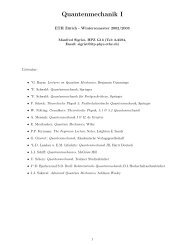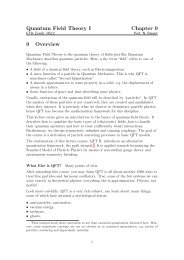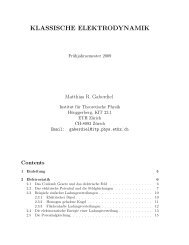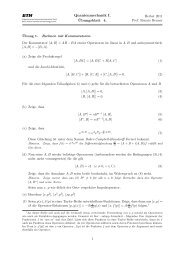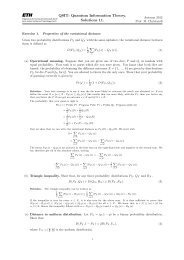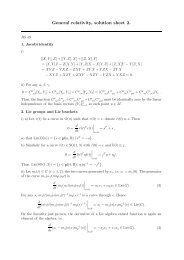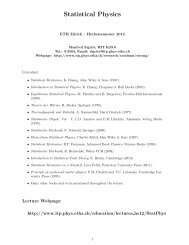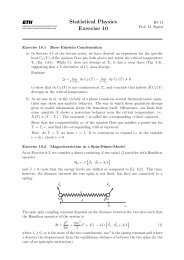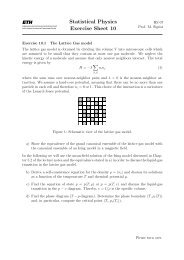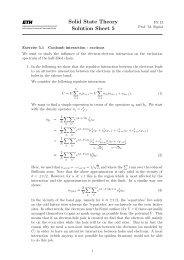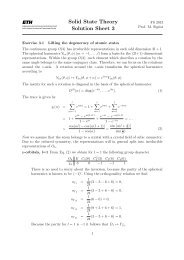Solid State Theory Exercise 2 Point groups and their representations ...
Solid State Theory Exercise 2 Point groups and their representations ...
Solid State Theory Exercise 2 Point groups and their representations ...
You also want an ePaper? Increase the reach of your titles
YUMPU automatically turns print PDFs into web optimized ePapers that Google loves.
• Check for yourself that this matrix is given by<br />
⎛<br />
⎞<br />
E 0 − ε v w v v w u w<br />
v E 0 − ε v w w v w u<br />
w v E 0 − ε v u w v w<br />
A =<br />
v w v E 0 − ε w u w v<br />
v w u w E 0 − ε v w v<br />
⎜ w v w u v E 0 − ε v w<br />
⎟<br />
⎝ u w v w w v E 0 − ε v ⎠<br />
w u w v v w v E 0 − ε<br />
This matrix can be diagonalized by going into the symmetry subspaces. We will show<br />
that for the energies <strong>and</strong> the wave functions one finds<br />
where E 0 = 2<br />
2m 3( 2π a )2 .<br />
Γ + 1 : E 0 + u + 3v + 3w cos ( 2π<br />
x) cos ( 2π<br />
y) cos ( 2π<br />
z) ;<br />
a a a<br />
Γ − 2 : E 0 − u − 3v + 3w sin ( 2π<br />
x) sin ( 2π<br />
y) sin ( 2π<br />
z) ;<br />
a a a<br />
Γ − 15 : E 0 − u + v − w { sin ( 2π<br />
x) cos ( 2π<br />
y) cos ( 2π<br />
z) , cyclic } { (<br />
;<br />
a a a<br />
Γ + 25 : E 0 + u − v − w cos 2π x) sin ( 2π<br />
y) sin ( 2π<br />
z) , cyclic } ;<br />
a a a<br />
(8)<br />
For V ≠ 0 the wave functions ψ j (⃗r) mix. Applying degenerate perturbation theory means<br />
we have to solve the secular equation:<br />
det A = 0<br />
which has to be solved for ε. By projecting suitable vectors onto the symmetry subspaces<br />
found in a) one can systematically construct an eigenbasis <strong>and</strong> with it find the energies.<br />
However, for relatively small systems it is often possible to guess the correct eigenfunctions<br />
using some symmetry properties of the basis functions of the irreducible <strong>representations</strong>.<br />
Since the physical eigenfunctions have to be periodic in real space it is natural to use<br />
combinations of cos(Gx) <strong>and</strong> sin(Gx) etc.<br />
1. The eigenfunction belonging to the subset Γ + 1 has to be totally symmetric under<br />
all the operations. Therefore, e 1 = ( 1 1 1 1 1 1 1 1 ) is an eigenvector<br />
with energy ε 1 = E 0 + u + 3v + 3w. The physical eigenfunction can be found as<br />
f 1 (⃗r) ∼ ∑ j ei ⃗ G j ⃗r ∼ cos(Gx) cos(Gy) cos(Gz).<br />
2. For Γ − 15 we need three functions which are odd under the inversion operation ⃗r → −⃗r.<br />
We therefore need an odd number of sin’s. What is left are the combinations<br />
f 3 (⃗r) ∼ sin(Gx) cos(Gy) cos(Gz), f 4 (⃗r) ∼ cos(Gx) sin(Gy) cos(Gz) <strong>and</strong> f 5 (⃗r) ∼<br />
cos(Gx) cos(Gy) sin(Gz). They correspond to the following vectors<br />
e 3 = ( 1 −1 −1 1 1 −1 −1 1 )<br />
e 4 = ( 1 1 −1 −1 1 1 −1 −1 )<br />
e 5 = ( 1 1 1 1 −1 −1 −1 −1 )<br />
with energy ε 3−5 = E 0 − u + v − w.<br />
• Using the character table, repeat the above steps to find the eigenfunction f 2 (⃗r)<br />
belonging to the subset Γ − 2 . Also compute its energy.



